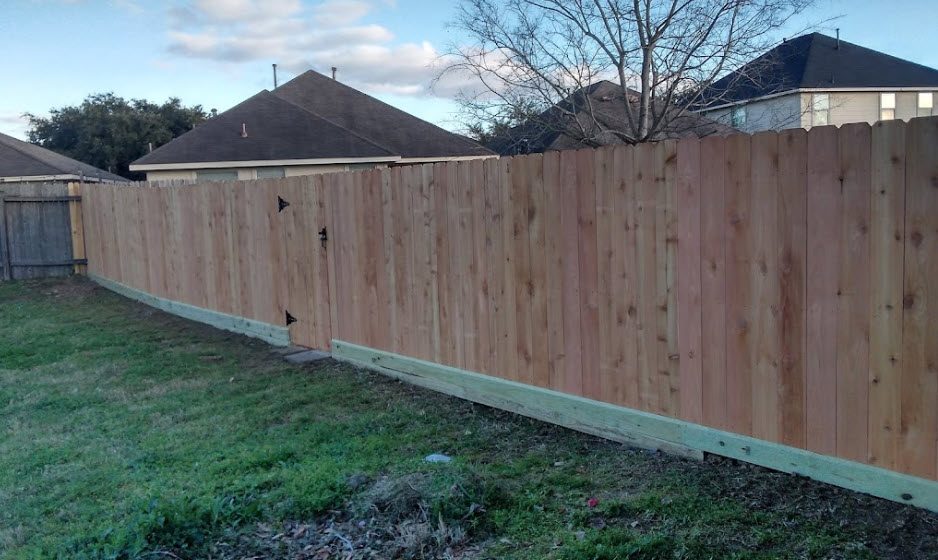New Fence Installation: What to Expect
When you choose our professional new fence installation services, you can expect a seamless process from start to finish. Our team will begin by assessing your property, discussing your design preferences, obtaining necessary permits, and then expertly installing your new fence with precision and care. Throughout the process, we prioritize clear communication, professionalism, and delivering a durable, high-quality fencing solution that meets your specific needs.

Preparing for a New Fence Installation
Getting a new fence is exciting, but there are essential things you need to do before the installation team arrives. First, make sure you notify the utility companies to mark any underground lines on your property. This is crucial because hitting any utility lines during the installation can be very dangerous and cause damage to your existing utilities.
After those lines are marked, it’s time to prepare the area where your new fence will be installed. Clearing away any debris, plants, or obstacles from the fence line is crucial. This ensures that the installation team has easy access to work in the area without running into unnecessary obstructions and provides enough room for the materials and equipment needed during the process.
For instance, if you’re having a wooden fence installed and the area needs flat ground for cutting, preparing this beforehand might save time during installation. Similarly, for an iron or aluminum fence, ensuring that there are no thorny bushes or overhanging trees can provide easier navigation for the installation team.
Moreover, personal items such as garden furniture, grills, potted plants, and any other obstructions need to be removed from the installation area. This significantly reduces the chances of these items being accidentally damaged during the installation process.
Tip: Once you’ve arranged for your new fence installment, put these points at the top of your checklist to ensure a smooth and efficient process when our team arrives.
Essential Materials for Fence Building
When it comes to building a robust and enduring fence, the choice of materials plays a crucial role in its longevity and sturdiness. Let’s explore the key materials required for a successful fence construction project.
The most vital components that you will need include:
- Fence panels or pickets: Responsible for forming the main structure of your fence and available in various materials such as wood, vinyl, aluminum, or composite.
- Posts: The backbone of your fence, providing support and stability. Common options are wood, steel, or vinyl posts.
- Securing materials: Concrete or gravel is often used to firmly secure the posts into the ground, preventing shifting and leaning over time.
- Fasteners: Screws, nails, and brackets hold everything together securely, contributing to the overall strength of the fence.
- Tools: Essential tools include a post-hole digger, level, tape measure, and saw. These tools are crucial for measuring and cutting materials accurately, ensuring straight lines and proper installation.
It’s important to note that the quality of these materials significantly impacts the durability and appearance of your fence. For instance, using high-quality screws or fasteners prevents rust and decay, ensuring that your fence stays secure for years to come.
Moreover, choosing durable and weather-resistant fence panels or pickets is essential to withstand elements such as rain, snow, and sunlight—maintaining their appearance and structural integrity over time. The same holds true for the posts since they bear the weight and pressure of the entire fence structure.
Imagine buying a beautiful wooden fence panel only for it to warp and crack after a few seasons due to poor quality. This exemplifies why selecting top-notch materials is paramount—it’s an investment in the longevity of your property’s aesthetics and security.
At our company, we understand the significance of using premium materials for fence installations. We take pride in sourcing high-quality components that are built to last. By doing so, we ensure that every fence we build not only serves its practical purpose but also enhances the beauty and value of your property for years to come.
Accurate Property Measurements for Fencing
When installing a new fence, it’s vital to begin with precise property measurements. This ensures the right amount of materials are ordered and the installation is completed without encroaching on neighboring properties or public areas. Picture building a fence that ends up on your neighbor’s land! To avoid such an unpleasant scenario, property surveys can help determine the exact property lines and ensure compliance with local zoning laws and homeowners’ association regulations.
Our experience has taught us that accuracy here is key. We’ve firsthand witnessed how improper measurements can lead to costly disputes and legal issues. That’s why professional help at this stage is recommended. Engaging a licensed surveyor will provide an official blueprint of your property lines, which you can then share with your fencing contractor.
Importance of Property Surveys
Property surveys are akin to drawing a map that show where your property begins and ends, reducing the risk of accidentally building on someone else’s land. These documents play a crucial role in ensuring compliance with local regulations and zoning laws, including obtaining necessary permits for your project, providing peace of mind knowing you’re staying within legal boundaries.
In addition to property lines, other factors like uneven terrains and obstacles should factor into the measurements as they can impact the installation process and the amount of materials needed.
For instance, slopes in the land may require stepped panels or specific installations to ensure the fence stays level and looks its best throughout its length. Thus, it’s not just about length and width but also about understanding all aspects of your property that could influence your fence layout.
Remember, installing a fence isn’t just about your property; it’s about being considerate to your neighbors and maintaining harmony within your community. The last thing anyone wants is a dispute over property lines or zoning violations due to an improperly placed fence.
Getting these measurements exactly right from the beginning makes the rest of the project go much smoother, ensuring proper compliance and avoiding any potential issues down the road.
Installation Day Expectations
So, it’s finally the big day – the day your new fence is being installed! It’s an exciting milestone, but it might also bring with it some uncertainty and questions about what will happen and how you can prepare for it. Fear not, because we’re here to guide you through the expectations you can have for this memorable day.
Crew Arrival and Introduction
Upon our professional crew’s arrival at your property, they’ll initiate by introducing themselves and thoroughly go through their intended plan of action. This forms part of our commitment to excellent customer service—you should feel comfortable and well-informed every step of the way.
They’ll organize their tools, discuss the plan of action, re-confirm the layout of the fence and materials to be used to ensure that all parties are on the same page before they begin any work.
Clearing the Installation Area
Before commencing any work, our team will inspect and clear the new fence installation area from clutter or debris that might hinder their progress. This proactive step allows them to assess the site confidently and proceed with work without interruptions.
For instance, if there are bushes or plants in the way, these might need to be temporarily moved or trimmed so they don’t obstruct the construction route. These tasks ensure that your yard is properly prepped for safe and efficient fence installation.
Setting Up Equipment
As they prepare the area, our experts will proceed with setting up their equipment in a strategic manner. You’ll notice them staging racks of fencing materials and possibly driving stakes into the ground to mark where each post will be located. This phase is crucial as it sets the stage for seamless installation.
Just like a perfectly choreographed dance routine, everyone has a role in setting up equipment—it’s a synchronized effort that ensures no time is wasted during the installation process.
Noise Levels and Disruption
There will be some noise and commotion as heavy machinery might be used to dig holes for posts or adjust materials. While it’s normal for there to be some disruption on installation day, rest assured that your installation team will strive to minimize any inconvenience to you and your neighbors.
Overall, understanding what to expect when getting a new fence installed eases any anxiety around installation day. Being informed about each step makes it easier for you to support the crew during their efforts. Our crew focuses on ensuring satisfaction from start to finish—creating beautiful fences while keeping your peace of mind intact.
Contractor Arrival and Set-Up
When the day arrives for the commencement of your new fence installation, the sound of a vehicle pulling up can be exciting—it signifies that the professionals you’ve hired are about to bring your vision to life. The contractor and their team will arrive with all the necessary equipment, tools, and materials required to transform your property.
Upon arrival, it’s crucial for the team to assess and strategize the placement of fence posts. They may mark these locations using specialized tools or by spraying the ground. This step is essential as it lays the foundation for a straight and sturdy structure. Next, they’ll unpack and set up their tools, ensuring they have everything needed for the tasks at hand.
Ensuring Safety Measures
The team will also need to ensure that safety measures are implemented from the outset. This includes having clear access to the work area, keeping any pets or children away from the construction site for their safety, and ensuring that any potentially hazardous areas are correctly marked.
This attention to detail right from the onset fosters a safe working environment and sets in motion a smooth and efficient installation process.
Imagine this: Before starting any digging, our team leader surveys your landscape like an artist planning out their next masterpiece. You can see them calculating distances and double-checking measurements. They’re meticulous because we understand how vital it is to get it right from the very beginning.
Ultimately, professional local companies like Texas Fence prioritize this thorough approach to ensure that every project gets off on the right foot. They know that a structured set-up process leads to success during the actual installation.
The initial phases have been precisely mapped out, marking an excellent start to what is sure to be an efficient and well-executed installation process. Next, let’s delve into the intricate process of excavating post holes and paying close attention to spacing and depth to lay down a strong foundation for your new fence.
The Fence Installation Process
When our team arrives on site, they start by meticulously planning and marking the boundaries where the fence will be installed—a crucial step to ensure precision and accuracy throughout the entire installation process.
Digging Post Holes
After setting the boundaries, the team proceeds to dig post holes. This phase demands careful attention to detail—depth is especially crucial, varying depending on the type and height of the fence being installed. A sturdy foundation is key to a long-lasting fence; thus, ensuring each post hole is of consistent depth and width provides stability and uniformity for the entire fence structure.
The team meticulously measures and ensures that the posts are appropriately distanced from each other, guaranteeing a structurally sound fence. Concrete or gravel is used to securely fix the posts in place, preventing leaning or displacement over time.
Attaching Panels or Pickets
Once the posts are solidly positioned, it’s time for attaching the panels or pickets. The meticulous care taken during this stage ensures that each panel or picket fits seamlessly with precise alignment. Whether it’s a sleek privacy fence or a charming picket fence, even spacing and level placement create a polished and professional final result.
For example, during the installation of a classic wooden picket fence, we ensure every picket shares an equal gap for both aesthetic appeal and functionality. Each panel is aligned perfectly, resulting in an evenly distributed and seamless appearance.
The proper attachment of panels or pickets not only contributes to visual appeal but also determines the overall structural integrity of your new fence. When everything fits snugly into place, your fence reflects our dedication to delivering high-quality craftsmanship.
By meticulously following these steps, we ensure that every element of your new fence installation meets our rigorous quality standards. Our mission is to provide you with a durable, attractive, and reliable addition to your property—something you can admire for years to come.
As we’ve explored what to expect during a new fence installation, understanding the various factors influencing costs becomes imperative. Now let’s delve into assessing what goes into determining fence installation expenses.
Assessing Fence Installation Cost
When considering a new fence, understanding the related costs is crucial for making informed decisions. Breaking down the factors influencing installation costs and ensuring that you’re getting a fair deal is essential.
The type of material for your fence significantly impacts the overall cost. For instance, wood fences tend to be more affordable to install than vinyl or wrought iron options. However, it’s important to consider maintenance costs as wooden fences may require more upkeep over time.
In addition to material, the linear footage of your property that needs fencing is influential. The larger the area to be fenced, the more materials and labor will be required, leading to a higher overall cost.
Labor costs are another essential component that contributes significantly to the total cost. Different types of fences may require varying levels of expertise and effort to install, impacting the labor costs involved. For instance, intricate designs or specialized materials may incur higher labor expenses.
Additionally, considering any additional features or customizations you desire is important. Including gates, decorative elements, or specific design features naturally affects the total cost of installation.
According to industry experts, obtaining multiple quotes from local professional companies is key to securing a competitive deal. Statistics show that homeowners who compare quotes from at least three reputable fence contractors are more likely to secure a competitive deal.
By understanding various factors influencing fence installation costs and leveraging this knowledge when engaging with local professionals, you can make informed decisions that align with your budget whilst ensuring quality installation.
Equipped with valuable insights into fence installation costs, let’s now shift our focus to what you should anticipate after the completion of your fence installation.
Expectations Post-Fencing Installation
Once the installation is complete, it’s crucial to carry out a final inspection with the contractor. This last walk-through is vital. You and the contractor should scrutinize every inch of the new fence to ensure it meets your expectations and aligns with the agreed-upon terms. Take this time to bring up any concerns or questions you might have regarding the installation.
Listen carefully to any specific care instructions for your new fence provided by the professional local fence company. These instructions are tailored to maintain the integrity of your fence and can ensure its longevity. Also, inquire about any warranty offered following the fence installation. Understanding what falls under warranty coverage, such as repairs for faulty workmanship, can give you peace of mind, knowing that you won’t be left high and dry if something goes wrong shortly after the installation.
Some people think that this step is unnecessary, but it’s important to safeguard your investment by ensuring everything is in place and asking pertinent questions.
For instance, say you notice some uneven gaps between fence posts or missing components from your fencing project during this walk-through. Getting these fixed immediately will rectify issues early on before they escalate or worsen over time.
Moreover, if ongoing maintenance services are offered by the contractor, it’s helpful to know what those entail post-installation. That way, if you encounter unexpected issues down the line – like one picket starting to warp – you’ll know who to call. Having an established relationship with a local professional can pay dividends in terms of ongoing peace of mind.
By covering all these bases post-installation, not only do you ensure that everything meets your expectations and standards, but you also acquire valuable information and resources for maintaining your investment down the line.
After the fence installation journey, ensuring a thorough final inspection and understanding post-installation care instructions are integral steps to safeguarding your investment. For further assistance or inquiries, don’t hesitate to contact our team at Texas Fence by calling us at (281) 807-7900.








